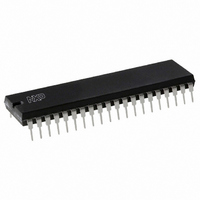P87C52X2FN,112 NXP Semiconductors, P87C52X2FN,112 Datasheet - Page 21

P87C52X2FN,112
Manufacturer Part Number
P87C52X2FN,112
Description
IC 80C51 MCU 256 RAM 40DIP
Manufacturer
NXP Semiconductors
Series
87Cr
Datasheet
1.P87C52X2BN112.pdf
(62 pages)
Specifications of P87C52X2FN,112
Core Processor
8051
Core Size
8-Bit
Speed
33MHz
Connectivity
EBI/EMI, UART/USART
Peripherals
POR
Number Of I /o
32
Program Memory Size
8KB (8K x 8)
Program Memory Type
OTP
Ram Size
256 x 8
Voltage - Supply (vcc/vdd)
2.7 V ~ 5.5 V
Oscillator Type
Internal
Operating Temperature
-40°C ~ 85°C
Package / Case
40-DIP (0.600", 15.24mm)
Processor Series
P87C5x
Core
80C51
Data Bus Width
8 bit
Data Ram Size
256 B
Interface Type
UART
Maximum Clock Frequency
33 MHz
Number Of Programmable I/os
32
Number Of Timers
3
Operating Supply Voltage
2.7 V to 5.5 V
Maximum Operating Temperature
+ 85 C
Mounting Style
SMD/SMT
3rd Party Development Tools
PK51, CA51, A51, ULINK2
Minimum Operating Temperature
- 40 C
Package
40PDIP
Device Core
80C51
Family Name
87C
Maximum Speed
33 MHz
Lead Free Status / RoHS Status
Lead free / RoHS Compliant
Eeprom Size
-
Data Converters
-
Lead Free Status / Rohs Status
Details
Other names
935269602112
P87C52X2FN
P87C52X2FN
P87C52X2FN
P87C52X2FN
Philips Semiconductors
Baud Rate Generator Mode
Bits TCLK and/or RCLK in T2CON (Table 4) allow the serial port
transmit and receive baud rates to be derived from either Timer 1 or
Timer 2. When TCLK= 0, Timer 1 is used as the serial port transmit
baud rate generator. When TCLK= 1, Timer 2 is used as the serial
port transmit baud rate generator. RCLK has the same effect for the
serial port receive baud rate. With these two bits, the serial port can
have different receive and transmit baud rates – one generated by
Timer 1, the other by Timer 2.
Figure 11 shows the Timer 2 in baud rate generation mode. The
baud rate generation mode is like the auto-reload mode, in that a
rollover in TH2 causes the Timer 2 registers to be reloaded with the
16-bit value in registers RCAP2H and RCAP2L, which are preset by
software.
The baud rates in modes 1 and 3 are determined by Timer 2’s
overflow rate given below:
The timer can be configured for either “timer” or “counter” operation.
In many applications, it is configured for “timer” operation (C/T2=0).
Timer operation is different for Timer 2 when it is being used as a
baud rate generator.
Usually, as a timer it would increment every machine cycle (i.e., 1/6
the oscillator frequency in 6-clock mode or 1/12 the oscillator
frequency in 12-clock mode). As a baud rate generator, it
increments at the oscillator frequency in 6-clock mode or at 1/2 the
oscillator frequency in 12-clock mode. Thus the baud rate formula is
as follows:
2003 Jan 24
80C51 8-bit microcontroller family
4K/8K/16K/32K ROM/OTP, low voltage (2.7 to 5.5 V),
low power, high speed (30/33 MHz)
Modes 1 and 3 Baud Rates + Timer 2 Overflow Rate
n = 1 in 6-clock mode
n = 2 in 12-clock mode.
OSC
T2EX Pin
T2 Pin
n
Transition
Detector
C/T2 = 0
C/T2 = 1
Note availability of additional external interrupt.
EXEN2
Control
Figure 11. Timer 2 in Baud Rate Generator Mode
16
TR2
Control
EXF2
RCAP2L
(8 bits)
Interrupt
21
Timer 2
TL2
When Timer 2 is in the baud rate generator mode, one should not try
Where:
The Timer 2 as a baud rate generator mode shown in Figure 11 is
valid only if RCLK and/or TCLK = 1 in T2CON register. Note that a
rollover in TH2 does not set TF2, and will not generate an interrupt.
Thus, the Timer 2 interrupt does not have to be disabled when
Timer 2 is in the baud rate generator mode. Also if the EXEN2
(T2 external enable flag) is set, a 1-to-0 transition in T2EX
(Timer/counter 2 trigger input) will set EXF2 (T2 external flag) but
will not cause a reload from (RCAP2H, RCAP2L) to (TH2,TL2).
Therefore when Timer 2 is in use as a baud rate generator, T2EX
can be used as an additional external interrupt, if needed.
to read or write TH2 and TL2. As a baud rate generator, Timer 2 is
incremented every state time (osc/2) or asynchronously from pin T2;
under these conditions, a read or write of TH2 or TL2 may not be
accurate. The RCAP2 registers may be read, but should not be
written to, because a write might overlap a reload and cause write
and/or reload errors. The timer should be turned off (clear TR2)
before accessing the Timer 2 or RCAP2 registers.
Table 5 shows commonly used baud rates and how they can be
obtained from Timer 2.
n = 16 in 6-clock mode, 32 in 12-clock mode.
(RCAP2H, RCAP2L)= The content of RCAP2H and RCAP2L
taken as a 16-bit unsigned integer.
Modes 1 and 3 Baud Rates =
(8 bits)
RCAP2H
TH2
Reload
[n
[65536 * (RCAP2H, RCAP2L)]]
Oscillator Frequency
P80C3xX2; P80C5xX2;
“1”
“1”
2
“0”
“0”
“0”
Overflow
Timer 1
“1”
16
16
P87C5xX2
SMOD
RCLK
TCLK
SU01625
Product data
RX Clock
TX Clock















